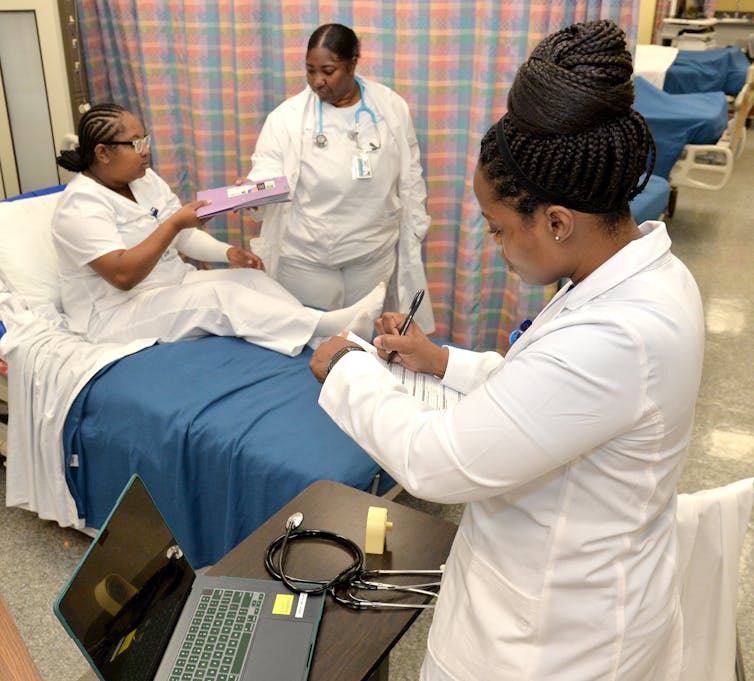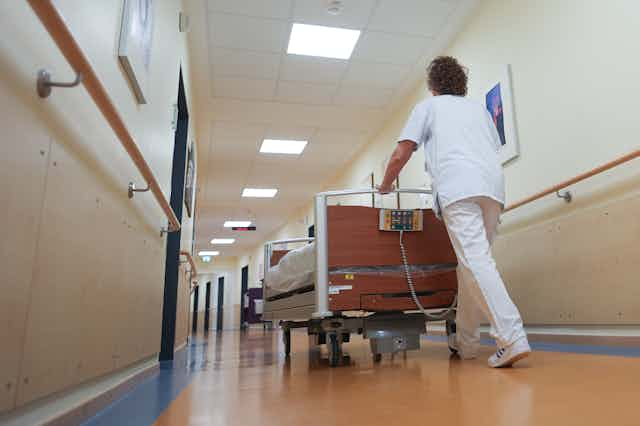Kymberlee Montgomery, Senior Associate Dean of Nursing, Drexel University
Mary Ellen Smith Glasgow, Professor of Nursing, Duquesne University
Imagine nearly every seat in Philadelphia’s Wells Fargo Center − over 20,000 seats − are empty. That’s the scale of Pennsylvania’s projected shortfall of registered nurses by 2026, according to the Hospital and Healthsystem Association of Pennsylvania.
Hospitals in the state report an average 14% vacancy rate for registered nurses. In rural areas it is much higher.
This shortage, of course, is not just in hospitals. It also affects long-term care facilities, outpatient clinics and home health agencies, which compete with hospitals for a limited pool of registered nurses, licensed nursing professionals and nursing support staff.
We are a senior associate dean of nursing and clinical professor of nursing at Drexel University’s College of Nursing and Health Professions in Philadelphia, and a dean and professor of nursing at Duquesne University’s School of Nursing in Pittsburgh.
We know that the nursing shortage in Pennsylvania, while not the worst in the U.S., is severe and jeopardizes the health care that patients receive.
What caused the shortage?
Pennsylvania’s nursing shortage is the result of long-standing issues in education, workforce retention and health care delivery.

Cost to patients
For patients and their families, the consequences of the nursing shortage are delayed care, fewer interactions with providers and less time for compassionate, personalized support. Overextended nurses face increased workloads, raising the likelihood of delayed interventions, medication errors and inadequate patient education. These factors undermine quality of care.
Limited access to nursing care can increase hospital deaths, infections and readmissions, reduce early detection of health issues, and slow the response to life-threatening conditions such as stroke, sepsis and cardiac arrest.
In Pennsylvania, patients may experience longer emergency room wait times, delayed discharges or transfers to nursing homes or rehabilitation centers, and service disruptions in rural and underserved areas.
Effect on nurses
Over 600,000 registered nurses across the U.S. plan to leave the workforce by 2027, according to a 2023 analysis by the National Council of State Boards of Nursing.
Many cite stress as their reason for leaving the profession. New graduates often leave within their first two years, feeling unprepared for the emotional and operational realities of practice.
In Pennsylvania, the shortage has created a feedback loop. Understaffing increases pressure on those who remain. A 2023 National Council of State Boards of Nursing survey found that 41% of nurses under age 35 reported feeling emotionally drained.
Meanwhile, some experienced nurses choose to retire early or shift into nonclinical roles for better schedules, slower pace and improved quality of life.
This turnover erodes institutional knowledge, increases costs for onboarding and overtime, and limits the capacity to mentor incoming staff.
What’s being done
To help address the problem, Pennsylvania Gov. Josh Shapiro in March 2025 proposed a US$5 million Nurse Shortage Assistance Program. If approved by the General Assembly, the program would cover tuition costs for nursing students who commit to working in Pennsylvania hospitals for three years after graduation.
HB 390 is also currently under review in the Pennsylvania General Assembly. It aims to establish a $1,000 tax deduction for licensed nurses who serve as clinical preceptors.
To meet the growing demand for nurses, Pennsylvania hospitals are partnering with colleges and universities to expand clinical training capacity, streamline pathways into nursing and develop innovative education models such as hybrid and accelerated programs.
Hospitals statewide are also offering substantial sign-on bonuses, loan forgiveness programs, housing stipends and flexible scheduling to attract nurses.
To improve nurse retention, health care organizations have introduced structured residency programs, mentorship networks and clear career advancement pathways designed to reduce burnout and enhance professional satisfaction.
They are also increasingly using virtual nursing, telehealth services and AI-driven administrative tools to reduce nurses’ workloads, enhance patient interactions and address staffing gaps.
And some Philadelphia and Pennsylvania colleges offer refresher and license reactivation programs for retired or inactive nurses who want to rejoin the workforce. Duquesne offers a nurse faculty residency to increase the number of high-quality nursing faculty.
What more could be done?
Continuing Title VIII Nursing Workforce Development Programs are another solution. These federal grants, reauthorized under the March 2020 CARES Act, help fund nursing pathways and the availability of high-quality nursing care for patients nationwide.
On April 1, 2025, the Trump administration announced plans to restructure the U.S. Department of Health and Human Services, and the future status of these programs is not yet known.
Research consistently demonstrates that care provided by nurses who have earned a bachelor’s degree or higher directly leads to better patient outcomes, improved safety and overall health. A commitment to shoring up the nurse pipeline in Pennsylvania is a commitment to improving the well-being of individuals and communities across the state.
This article is originally published in The Conversation website.


















